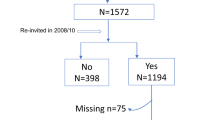Abstract
Prostate cancer is the commonest non-skin malignancy in the United States and has a substantial mortality rate despite the use of PSA-based screening. Furthermore, therapy for prostate cancer by surgery, radiotherapy or hormonal manipulation carries a significant risk of treatment-related morbidity. Recent analysis of secondary endpoints of several large-scale randomized prospective clinical trials for other malignancies has suggested that selenium or vitamin E may result in a decreased incidence and mortality from prostate cancer. In vitro and preclinical studies of these antioxidants support this hypothesis.
This review outlines the rationale and design of SELECT, the Selenium and Vitamin E Cancer Prevention Trial, designed to test the hypothesis that selenium or vitamin E alone or in combination can reduce the clinical incidence of prostate cancer in a population-based cohort of men at risk. SELECT is a phase III, randomized, double-blinded, prospective, 2×2 factorial clinical trial which will randomize 32,400 healthy men with normal DRE and serum PSA to one of four study arms: selenium alone, vitamin E alone, selenium+vitamin E, or placebo. Study agents will be taken orally for a minimum of 7 and maximum of 12 y with assessments of general health, incident prostate cancer and toxicity performed at 12 month intervals. Under the assumptions described, the detectable risk reduction is 25% for an effective single agent relative to placebo, with an additional 25% reduction for the combination relative to an effective single agent. The estimated power for the comparison of a single agent vs placebo is 96% and the power for the comparison of an effective single agent vs combination is 89%. Secondary endpoints will include prostate cancer-free survival, all-cause mortality, and the incidence and mortality of other cancers and diseases potentially impacted by the chronic use of selenium and vitamin E. Other trial objectives will include periodic quality of life assessments, assessment of serum micronutrient levels and prostate cancer risk, and studies of the evaluation of biological and genetic markers with the risk of prostate cancer.
This is a preview of subscription content, access via your institution
Access options
Subscribe to this journal
Receive 4 print issues and online access
$259.00 per year
only $64.75 per issue
Buy this article
- Purchase on Springer Link
- Instant access to full article PDF
Prices may be subject to local taxes which are calculated during checkout
Similar content being viewed by others
Author information
Authors and Affiliations
Corresponding author
Rights and permissions
About this article
Cite this article
Klein, E., Thompson, I., Lippman, S. et al. SELECT: the Selenium and Vitamin E Cancer Prevention Trial: rationale and design. Prostate Cancer Prostatic Dis 3, 145–151 (2000). https://doi.org/10.1038/sj.pcan.4500412
Received:
Revised:
Accepted:
Published:
Issue Date:
DOI: https://doi.org/10.1038/sj.pcan.4500412
Keywords
This article is cited by
-
Multilevel modeling and value of information in clinical trial decision support
BMC Systems Biology (2014)
-
A randomized controlled Alzheimer's disease prevention trial's evolution into an exposure trial: The preadvise trial
The Journal of nutrition, health and aging (2013)
-
Ethnic differences in prostate cancer
British Journal of Cancer (2011)
-
Selenium: a double-edged sword for defense and offence in cancer
Archives of Toxicology (2010)
-
In vitro evaluation of selenium genotoxic, cytotoxic, and protective effects: a review
Archives of Toxicology (2010)


